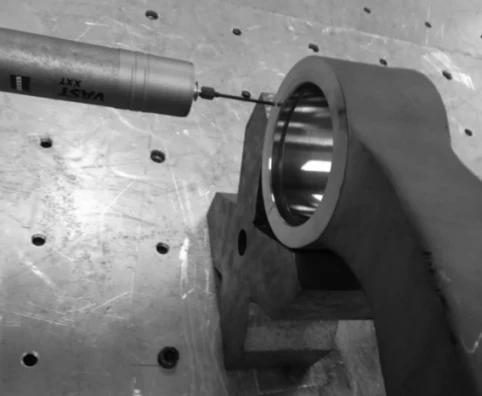1. Strict control of the process
In terms of processes, focus on ensuring the feasibility and accuracy of the process, formulate detailed process routes, quality plans, standardization outlines and other documents, and invite relevant personnel to carry out program demonstration and rectify the review comments. At the same time, the implementation of the process is strictly monitored, and the process is revised and improved according to the feedback in the actual production process; finally, the reliability of the valve is improved.
2. Controlling the source of materials
The material of marine valves directly determines the mechanical properties and reliability of the final product. There are castings, forgings, fasteners, sealing elements and electronic components. For casting materials, the riser can be reasonably set through the results of simulation analysis to effectively reduce casting defects such as internal porosity and shrinkage cavity. Use non-destructive testing such as a radiographic inspection to check the formed castings to ensure the quality of the castings, especially the parts that are prone to casting defects. At the same time, traceability should be done well, and records such as batch numbers and process documents should be kept to ensure the traceability of castings production. For forgings, it is necessary to control the quality of raw materials, and always pay attention to cracks in the forging process; take timely measures; in terms of inspection, strict chemical composition testing and mechanical property testing are required. In addition, non-destructive testing is required to ensure the reliability of the quality of forgings. For seals, pay attention to the preservation and protection of seals; avoid direct sunlight and storage in humid environments. At the same time, for seals in important sealing parts, re-inspection of sizes, materials and mechanical properties can be conducted.
3. Pursuit of precision in processing
There are many types of parts for valves with different specifications. There are hundreds of types of parts for complex valves. Among them, the valve body, valve stem, valve disc and other parts play a key role in the final sealing of the valve. The processing accuracy directly determines the reliability of the valve. In the machining process, it is necessary to strictly follow the machining process, and give feedback in time. For important parts and complex parts, the corresponding processing tooling can be used to assist the processing, and the processed parts should be distinguished. Mark and identify them, and carry out inspection. Key matching dimensions, important form and position tolerance can be tested on a three-coordinate measuring instrument, and inspection records should be kept. (Figure 1)

Figure 1 Using a three-coordinate measuring instrument to check the form and position tolerance of a certain type of part
In addition, the processed important sealing parts such as valve disc, valve stem, bushing and other parts are subject to great friction and wear during use, which affects the service life and reliability of the final product. Surface treatment can be used to improve the hardness and wear resistance of parts, effectively reduce the friction loss of materials and maintenance costs in the later period, and improve the quality and service life of valves.
4. Standard assembly
The preparation before assembly should be sufficient, and the parts should be cleaned and dried. A double-tank ultrasonic cleaner can be used to clean the parts to remove oil and impurities. Before assembly, transfer the drawings and assembly process to the assembly staff, and conduct relevant training on structure and assembly precautions of marine valves. The assembler should assemble in strict accordance with the standard operating procedures, and pays attention to protecting the parts in the process to avoid damage to the parts. When assembling for the first time, assemblers can assemble under the guidance of technicians throughout the process, record and solve problems at any time in time, and finally form a mature and stable assembly process.
5. Strengthening skills training
Aiming at each process in the manufacturing process, determine positions and responsibilities. At the same time, analyze the requirements of jobs, the basic skills required by specially skilled personnel in machining, assembly, debugging, and testing. Learn from others' strong points and close the gap, and give full play to the subjective initiative of skilled employees. Then, strengthen special skills training for fixed-post personnel; improve the skill of employees, and encourage innovation, invention, process improvement and optimization in the manufacturing process. Conduct comprehensive evaluation according to the actual work effect, and strengthen training for weak points, ensuring a high-level team and laying a solid foundation for the quality and reliability of the final product.
6. Innovation in technology
The manufacturing process of marine valves involves the intersection of multiple disciplines and industries. In the manufacturing process, personnel from various professions are required to cooperate, learn from each other, and carry out targeted optimization and improvement. In addition, attention should be paid to new materials and new technologies and timely accept and absorb them. Focus on independent technological innovation and the research and development and protection of core technologies; promote technological progress, and strengthen intellectual property awareness; in addition, it is necessary to strengthen the quality management of enterprises, strive to improve the quality of products, and enhance the core competitiveness of enterprises.
Conclusion
Since the beginning of the new century, the scale of China's valve industry has become larger and larger, and the valve manufacturing capacity and technical level have been continuously improved, all of which are inseparable from quality management. In the next step, it is necessary to strengthen the implementation and improvement of quality management and control measures, and carry out stricter control of the quality of materials. Meanwhile, pursue perfection in processing and inspection. Focus on the introduction of new materials and technologies. Continuously improve the manufacturing quality of valves, and improve the level of industrialization of enterprises.
